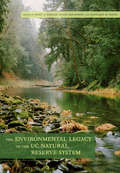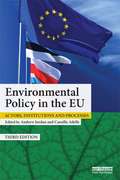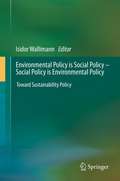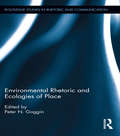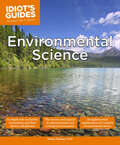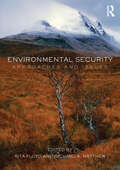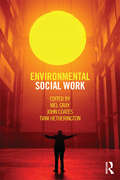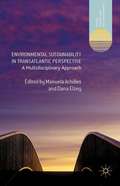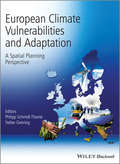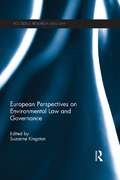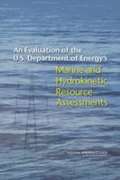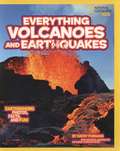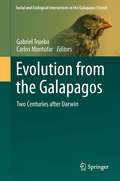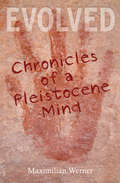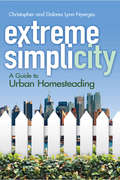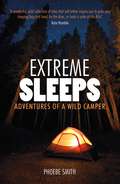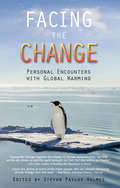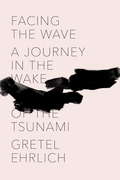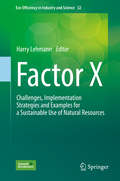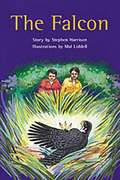- Table View
- List View
Environmental Infrastructure in African History
by Emmanuel KreikeEnvironmental Infrastructure in African History offers a new approach for analyzing and narrating environmental change. Environmental change conventionally is understood as occurring in a linear fashion, moving from a state of more nature to a state of less nature and more culture. In this model, non-Western and premodern societies live off natural resources, whereas more modern societies rely on artifact, or nature that is transformed and domesticated through science and technology into culture. In contrast, Emmanuel Kreike argues that both non-Western and premodern societies inhabit a dynamic middle ground between nature and culture. He asserts that humans- in collaboration with plants, animals, and other animate and inanimate forces - create environmental infrastructure that constantly is remade and reimagined in the face of ongoing processes of change.
The Environmental Legacy of the UC Natural Reserve System
by Kathleen M. Wong Peggy L. Fiedler Susan Gee RumseyThe UC Natural Reserve System, established in 1965 to support field research, teaching, and public service in natural environments, has become a prototype of conservation and land stewardship looked to by natural resource managers throughout the world. From its modest beginnings of seven sites, the UC NRS has grown to encompass more than 750,000 wildland acres. This book tells the story of how a few forward-thinking UC faculty, who'd had their research plots and teaching spots destroyed by development and habitat degradation, devised a way to save representative examples of many of California's major ecosystems. Working together with conservation-minded donors and landowners, with state and federal agencies, and with land trusts and private conservation organizations, they founded what would become the world's largest university-administered natural reserve system--a legacy of lasting significance and utility. This lavishly illustrated volume, which includes images by famed photographers Ansel Adams and Galen Rowell, describes the natural and human histories of the system's many reserves. Located throughout California, these wildland habitats range from coastal tide pools to inland deserts, from lush wetlands to ancient forests, and from vernal pools to oak savannas. By supporting teaching, research, and public service within such protected landscapes, the UC NRS contributes to the understanding and wise stewardship of the Earth.
Environmental Litigation in China
by Rachel E. SternThis is a book about the improbable: seeking legal relief for pollution in contemporary China. In a country known for tight political control and ineffectual courts, Environmental Litigation in China unravels how everyday justice works: how judges make decisions, why lawyers take cases, and how international influence matters. It is a readable account of how the leadership's mixed signals and political ambivalence play out on the ground - propelling some, such as the village doctor who fought a chemical plant for more than a decade, even as others back away from risk. Yet this remarkable book shows that even in a country where expectations would be that law wouldn't much matter, environmental litigation provides a sliver of space for legal professionals to explore new roles and, in so doing, probe the boundary of what is politically possible.
Environmental Policy in the EU: Actors, institutions and processes
by Andrew Jordan Camilla AdelleThe European Union (EU) has a hugely important effect on the way in which environmental policies are framed and implemented in many different parts of the world, but especially Europe. The new and comprehensively revised edition of this well-known textbook provides a state-of-the-art analysis of all the EU’s environmental policies. Comprising five parts, it covers the rapidly changing context in which EU environmental policies are made, the key actors who interact to co-produce policy and the most salient dynamics of policy making, ranging from decision making through to implementation and evaluation. Written by leading experts in the field, individual chapters examine how the EU is responding to a multitude of different problems including biodiversity loss, climate change, energy insecurity, and water and air pollution. They tease out the many important ways in which the EU's policies on these topics co-evolve with national and international environmental policies. In this third edition a mixture of learning features are employed to ensure that undergraduate and postgraduate students fully understand how EU policies in this vital area developed in the past and how they are now adapting to the rapidly evolving challenges of the twenty-first century.
Environmental Policy is Social Policy – Social Policy is Environmental Policy
by Isidor WallimannThis book argues that social and environmental policy should be synthetically treated as one and the same field, that both are but two aspects of the same coin - if sustainability is the goal. Such a paradigm shift is indicated, important, and timely to effectively move towards sustainability. This book is the first to take this approach and to give examples for it. Not to synthetically merge the two fields has been and will continue to be highly insufficient, inefficient and contradictory for policy and public administration aiming for a transformation towards a sustainable world. In general, social problems are dealt with in one "policy corner" and environmental problems in another. Rarely is social policy (at large) concerned with its impact on the environment or its connection with and relevance to environmental policy. Equally, environmental problems are generally not seen in conjunction with social policy, even though much environmental policy directly relates to health, nutrition, migration and other issues addressed by social policy. This book intends to correct the pattern to separate these very significant and large policy fields. Using examples from diverse academic and applied fields, it is shown how environmental policy can (and should) be thought of as social policy - and how social policy can (and should) simultaneously be seen as environmental policy. Tremendous benefits are to be expected.
Environmental Practice and Early American Literature
by Michael ZiserThis original and provocative study tells the story of American literary history from the perspective of its environmental context. Weaving together close readings of early American texts with ecological histories of tobacco, potatoes, apples, and honey bees, Michael Ziser presents a method for literary criticism that explodes the conceptual distinction between the civilized and natural world. Beginning with the English exploration of Virginia in the sixteenth century, Ziser argues that the settlement of the "New World" - and the cultivation and exploitation of its bounty - dramatically altered how writers used language to describe the phenomena they encountered on the frontier. Examining the work of Harriot, Grainger, Cooper, Thoreau and others, Ziser reveals how these authors, whether consciously or not, transcribed the vibrant ecology of North America, and the ways that the environment helped codify a uniquely American literary aesthetic of lasting importance.
Environmental Rhetoric and Ecologies of Place (Routledge Studies in Rhetoric and Communication)
by Peter N. GogginUnderstanding how rhetoric, and environmental rhetoric in particular, informs and is informed by local and global ecologies contributes to our conversations about sustainability and resilience — the preservation and conservation of the earth and the future of human society. This book explores some of the complex relationships, collaborations, compromises, and contradictions between human endeavor and situated discourses, identities and landscapes, social justice and natural resources, movement and geographies, unpacking and grappling with the complexities of rhetoric of presence. Making a significant contribution to exploring the complex discursive constructions of environmental rhetorics and place-based rhetorics, this collection considers discourses, actions, and adaptations concerning environmental regulations and development, sustainability, exploitation, and conservation of energy resources. Essays visit arguments on cultural values, social justice, environmental advocacy, and identity as political constructions of rhetorical place and space. Rural and urban case studies contribute to discussions of the ethics and identities of environment, and the rhetorics of environmental cartography and glocalization. Contributors represent a range of specialization across a variety of scholarly research in such fields as communication studies, rhetorical theory, social/cultural geography, technical/professional communication, cartography, anthropology, linguistics, comparative literature/ecocriticism, literacy studies, digital rhetoric/media studies, and discourse analysis. Thus, this book goes beyond the assumption that rhetorics are situated, and challenges us to consider not only how and why they are situated, but what we mean when we theorize notions of situated, place-based rhetorics.
Environmental Science: An In-Depth Look at Earth’s Ecosystems and Diverse Inhabitants (Idiot's Guides)
by James DaurayEnvironmental science is an integrated, interdisciplinary field that combines the study of ecology, physics, chemistry, biology, soil science, geology, atmospheric science, and geography. It is among the top 10 most popular Advanced Placement examinations taken by high school seniors in an effort to receive postsecondary college credit. Idiot's Guides: Environmental Science provides a step-by-step review of the disciplines that comprise environmental science, helping students grasp the basic concepts, internalize the information, and prepare for exams. Features include: The basics and history of the human relationship with the natural environment. The ways species grow, change, and interact. A detailed description of the earth's ecosystems, including deserts, grasslands, forests, and aquatic ecosystems. The effects of economics and agriculture on the environment. The various types of energy humans use, as well as how its production impacts the earth's ecosystems, with a focus on renewable energy sources. The ill effects of a growing population, including pollution, toxins, bacteria, waste, and global warming/climate change.
Environmental Security: Approaches and Issues
by Rita Floyd Richard MatthewEconomic development, population growth and poor resource management have combined to alter the planet’s natural environment in dramatic and alarming ways. For over twenty years, considerable research and debate have focused on clarifying or disputing linkages between various forms of environmental change and various understandings of security. At one extreme lie sceptics who contend that the linkages are weak or even non-existent; they are simply attempts to harness the resources of the security arena to an environmental agenda. At the other extreme lie those who believe that these linkages may be the most important drivers of security in the 21st century; indeed, the very future of humankind may be at stake. This book brings together contributions from a range of disciplines to present a critical and comprehensive overview of the research and debate linking environmental factors to security. It provides a framework for representing and understanding key areas of intellectual convergence and disagreement, clarifying achievements of the research as well as identifying its weaknesses and gaps. Part I explores the various ways environmental change and security have been linked, and provides principal critiques of this linkage. Part II explores the linkage through analysis of key issue areas such as climate change, energy, water, food, population, and development. Finally, the book concludes with a discussion of the value of this subfield of security studies, and with some ideas about the questions it might profitably address in the future. This volume is the first to provide a comprehensive overview of the field. With contributions from around the world, it combines established and emerging scholars to offer a platform for the next wave of research and policy activity. It is invaluable for both students and practitioners interested in international relations, environment studies and human geography.
Environmental Social Work: Racial Preference In Black And White (Positions: Education, Politics, And Culture Ser.)
by Tim J. WiseSocial work has been late to engage with the environmental movement. Often working with an exclusively social understanding of environment, much of the social work profession has overlooked the importance of environmental issues. However, recently, the impact of and worldwide attention to climate change, a string of natural disasters, and increased understanding of issues around environmental justice has put the environment, sustainability, and well-being in the spotlight. Divided into three parts, this field-defining work explores what environmental social work is, and how it can be put into practice. The first section focuses on theory, discussing ecological and social justice, as well as sustainability, spirituality and human rights. The second section comprises case studies of evolving environmental social work practice. The case studies derive from a range of areas from urban gardens and community organizing to practice with those affected by climate change. The final section – relevant to students and lecturers – looks at learning about environmental issues in social work. Environmental Social Work provides an integrated theoretical and practical overview of why and how social work might respond to environmental factors affecting the societies and people they work with at international, national, local and individual levels.
Environmental Sustainability in Transatlantic Perspective: A Multidisciplinary Approach
by Manuela Achilles Dana ElzeyExperts from business, academia, governmental agencies and non-profit think tanks to form a transnational and multi-disciplinary perspectives on the combined challenges of environmental sustainability and energy security in the United States and Germany.
European Climate Vulnerabilities and Adaptation
by Stefan Greiving Philipp Schmidt-ThomeEuropean Climate Vulnerabilities and Adaptation: A Spatial Planning Perspective analyses the impacts climate change might have on regions and their local economies. Regions clearly differ in view of the complex patterns of climate change impact, but also regarding the given vulnerability and coping capacity.Impacts of climate change can have a marked effect on the functioning of regions and sectors of the society, if not properly addressed. Readiness to adapt to the impacts and lasting changes counts towards vulnerability of the regions.The book builds upon the findings of a project conducted under the European observation network for territorial development and cohesion (ESPON), The ESPON Climate project. Following the stipulations of the ESPON programme and the tender for this project the territorial focus is the raison d'être and methodological core of the project as a whole and its various research actions: The outcomes of each action will be focused on what impacts global climate change will have for the different European regions and how the regions can cope with the projected impacts in order to become less vulnerable to climate change.This book: Provides a comprehensive analysis of climate change impacts on 29 European regions and their local economiesTakes an interdisciplinary approach dealing with the physical, social, economic, environmental, cultural and institutional aspects of climate change vulnerability and the consequences for spatial planningBuilds on the findings of the ESPON Climate project with a policy focused approachIs in full colour throughout with a broad range of case studies
European Perspectives on Environmental Law and Governance (Routledge Research in EU Law)
by Suzanne KingstonThis book provides a range of perspectives on some of the most pressing contemporary challenges in EU environmental law and governance from some of today’s leading European environmental academics and practitioners. The book maintains a focus on three key cross-cutting issues, each of which is carefully analysed through the lens of governance. The first theme to be addressed is that of climate change and the problems it poses for EU governance. The second issue explored concerns the challenge of integrating environmental considerations into other policy areas, as is required by the Treaty on the Functioning of the European Union and the EU’s Charter of Fundamental Rights. Finally, the third theme centres on the important challenge of improving environmental enforcement within the EU, and considers issues such as the Aarhus Convention and the evolution of the Commission’s work on implementation and enforcement throughout the past twenty years. Each of these three themes is situated within the broader ongoing debate about the changing nature of European environmental governance post-Lisbon and the ways in which developments in this area fits within broader trends in European governance theory and policy generally. European Perspectives on Environmental Law and Governance contains contributions from experts in the field including; Mary Robinson, Alan Boyle, Ludwig Kramer and Liam Cashman, and will be of interest to academics, students and practitioners of EU environmental law.
An Evaluation of the U.S. Department of Energy’s Marine and Hydrokinetic Resource Assessments
by Marine Hydrokinetic Energy Technology Assessment CommitteeIncreasing renewable energy development, both within the United States and abroad, has rekindled interest in the potential for marine and hydrokinetic (MHK) resources to contribute to electricity generation. These resources derive from ocean tides, waves, and currents; temperature gradients in the ocean; and free-flowing rivers and streams. One measure of the interest in the possible use of these resources for electricity generation is the increasing number of permits that have been filed with the Federal Energy Regulatory Commission (FERC). As of December 2012, FERC had issued 4 licenses and 84 preliminary permits, up from virtually zero a decade ago. However, most of these permits are for developments along the Mississippi River, and the actual benefit realized from all MHK resources is extremely small. The first U. S. commercial gridconnected project, a tidal project in Maine with a capacity of less than 1 megawatt (MW), is currently delivering a fraction of that power to the grid and is due to be fully installed in 2013. As part of its assessment of MHK resources, DOE asked the National Research Council (NRC) to provide detailed evaluations. In response, the NRC formed the Committee on Marine Hydrokinetic Energy Technology Assessment. As directed in its statement of task (SOT), the committee first developed an interim report, released in June 2011, which focused on the wave and tidal resource assessments (Appendix B). The current report contains the committee's evaluation of all five of the DOE resource categories as well as the committee's comments on the overall MHK resource assessment process. This summary focuses on the committee's overarching findings and conclusions regarding a conceptual framework for developing the resource assessments, the aggregation of results into a single number, and the consistency across and coordination between the individual resource assessments. Critiques of the individual resource assessment, further discussion of the practical MHK resource base, and overarching conclusions and recommendations are explained in An Evaluation of the U. S. Department of Energy's Marine and Hydrokinetic Resource Assessment.
Everything Volcanoes and Earthquakes (National Geographic Kids Everything)
by Kathy Furgang Carsten PeterNational Geographic Kids Everything Volcanoes and Earthquakes explodes with incredible photos and amazing facts about the awesome powers of nature. <P><P>You'll find out that three-quarters of Earth's volcanoes are underwater, that an earthquake in Chile shortened the day by 1.26 milliseconds, and much more. <P><P>Bursting with fascinating information about the biggest volcanic eruptions and earth-shattering earthquakes, this book takes a fun approach to science, introducing kids to plate tectonics and the tumultuous forces brewing beneath the Earth's surface.
Evolution from the Galapagos: Two Centuries after Darwin
by Carlos Montúfar Gabriel TruebaThis volume is a collection of the some of the most significant lectures that well-known experts presented at our two international "summits on evolution" (2005, 2009) as updated and revised chapters. The meetings took place on one of the large islands of the Galapagos archipelago (San Cristobal) at GAIAS (Galapagos Institute for the Arts and Sciences) of the Universidad San Francisco de Quito (USFQ), Ecuador. The main goal of the two Galapagos Summits on Evolution has been to bring together scientists and graduate students engaged in the study of evolution, from life's origin to its current diversity. Because of their historical significance, the Galapagos are a unique venue for promoting comprehensive research on evolution and ecology and to make the research results available to students and teachers everywhere, but especially from developing countries. As shown by the enthusiastic attendance at both summits and the many suggestions to keep them continuing, the meetings have opened new opportunities for students from Ecuador and other Latin American countries to be inspired by some of the most brilliant minds in evolutionary science.
Evolved
by Maximilian Werner John AlcockFrom which side of the bed you sleep on to where to play a backyard game of hide-and-go-seek, Maximilian Werner examines elements of everyday behavior through the eye-opening lens of evolutionary theory in this memoir-infused nonfiction. Werner applies an intriguingly fresh take to seldom-explored habits of humans and animals alike, guiding readers backward in time to the Pleistocene."Werner's prose is compelling, his natural history is thoroughly engaging, and his line of curious inquiry is an admirable attempt to better understand humanity and its changing relationship with the external world."-Publishers Weekly"This book provides an entry in to the great epic of evolution in a way that makes it both accessible and inspiring. This is no small accomplishment and we are all indebted to Maximilian Werner."-Mary Evelyn Tucker, co- author, Journey of the Universe"Join this sensitive and perceptive naturalist as he explores his yard and nearby caves and mountains, carefully observing the activities of myriad life forms, and then reflecting insightfully on the evolutionary story we share with them. Learn from him how to feel completely at home in the world."-Loyal Rue, author of Religion is Not about God: How Spiritual Traditions Nurture Our Biological Nature and What to Expect When They Fail"Werner's book, thought-provoking and emotionally satisfying, takes us on a journey, a journey that ultimately urges each one of us to get up, go outside and hunt around the edges of our homes for the mysteries that await."-Sylvia Torti, author of The Scorpion's Tail
Extreme Simplicity: A Guide to Urban Homesteading
by Christopher Nyerges Dolores Lynn NyergesThis perfect guide to self-sufficient city dwelling was written by a pair of gentle survivalists who brought nature to their Los Angeles home. Christopher and Dolores Lynn Nyerges are prepared for everything from power failures and terrorist attacks to droughts and earthquakes. They'll show you the path to self-reliance, with strategies for coping with disasters as well as making the most of everyday life.The authors explain how to use available natural resources in an intelligent, efficient way. Their methods include growing and preserving garden produce and finding wild edibles; harvesting storm runoff for backup water supplies; preparing food with a wood stove and solar cooker; recycling everything from bottle caps to wood chips; keeping chickens, bees, and other animals; and much more.
Extreme Sleeps: Adventures of a Wild Camper
by Phoebe SmithGlobetrotter Phoebe Smith sets out to prove that outdoor adventures are available in the UK which rival anything found elsewhere in the world. In this sometimes scary and frequently funny journey around the country, Phoebe attempts to conquer its wildest places, defy her perceptions of the great outdoors and teach her about herself along the way.
Facing the Change
by Steven Pavlos Holmes"Amidst the current deluge of statistics about global warming, this book provides a refreshing look at how individuals are affected. This is a beautiful book to keep near, open at random, and share the words of gifted writers as they prepare for the coming changes."-Publishers Weekly"Holmes, a scholar in environmental humanities, has assembled a rich, varied collection of personal accounts and poems...An artistic and intimate approach to the problem that humanizes our concerns."--Booklist"How do you respond when the familiar, benevolent, and predictable world you count on becomes strange, hostile, and chaotic? First, you must face it. Next, bear witness. Steven Holmes has gathered compelling testimonies about the ways our earthly home is changing in the short space of our own lifetimes. They beg us to pay attention and act. We are wise to heed these passionate voices."-Chip Ward, author of Hope's Horizon"These earnest and heartfelt poems, essays, and imaginings change our discourse from data to personal testimony, channeling 'care and concern.' Maybe, just maybe, these authors who call us to 'unheroic' action 'on life's behalf' will steer us away from tragedy and chaos. 'Emerging from denial is like moving from blindness to light.' As the refrain from one writer puts it, 'Good Lord! Good luck!'"-Stephen Trimble, author of Bargaining for Eden: The Fight for the Last Open Spaces in America"Facing the Change shares the stories of some of the many people in the US and the world who are already witnessing climate change here and now. They are giving us early warning signs; it's up to all of us to act now."-Mae Boeve, executive director of 350.org"Facing the Change registers the impact of climate destabilization, not only on the sky above us and the earth beneath our feet, but also within our hearts. The voices in this eloquent and original book convey the dread and grief, the anger, but also the experiences of love and community that are intensified by the defining ecological challenge of our time."-John Elder, author of Reading the Mountains of Home, editor of The Norton Book of Nature"These eloquent stories, essays, and poems by scores of 'emotional and cultural first responders' to the effects of climate change are sure to deliver a powerful wake-up call to anyone who has supposed that nothing an individual person can say or do will affect this impending disaster."-Lawrence Buell, author of The Environmental Imagination"...the contributors to Facing the Change have begun to reveal the experiential heart of a planetary process. This is a truly important project." -Scott Slovic, editor of ISLE: Interdisciplinary Studies in Literature and EnvironmentFilled not with bare facts and dire warnings but with evocative, accessible stories, essays, and poetry, Facing the Change shows how global warming is affecting the everyday lives of people today. A wide range of writers brings courage, honesty, and insight to one of the major issues of our lives.Steven Pavlos Holmes, Ph.D., is an independent scholar in the environmental humanities, with a special interest in people's personal experiences of the natural world. His first book, The Young John Muir: An Environmental Biography, won the Modern Language Association's Prize for Independent Scholars. He lives in Jamaica Plain, Massachusetts.
Facing the Wave: A Journey in the Wake of the Tsunami
by Gretel EhrlichA passionate student of Japanese poetry, theater, and art for much of her life, Gretel Ehrlich felt compelled to return to the earthquake-and-tsunami-devastated Tohoku coast to bear witness, listen to survivors, and experience their terror and exhilaration in villages and towns where all shelter and hope seemed lost. In an eloquent narrative that blends strong reportage, poetic observation, and deeply felt reflection, she takes us into the upside-down world of northeastern Japan, where nothing is certain and where the boundaries between living and dying have been erased by water. The stories of rice farmers, monks, and wanderers; of fishermen who drove their boats up the steep wall of the wave; and of an eighty-four-year-old geisha who survived the tsunami to hand down a song that only she still remembered are both harrowing and inspirational. Facing death, facing life, and coming to terms with impermanence are equally compelling in a landscape of surreal desolation, as the ghostly specter of Fukushima Daiichi, the nuclear power complex, spews radiation into the ocean and air. Facing the Wave is a testament to the buoyancy, spirit, humor, and strong-mindedness of those who must find their way in a suddenly shattered world.
Factor X
by Harry LehmannFactor X: Re-source Designing the Recycling Society explores the role of recycling in efforts to achieve the sustainable world envisioned in the Federal Environment Ministry s Resource Efficiency Programme, known as ProgRess. The chapters build a roadmap to a Recycling Society in which the decoupling of resource consumption and economic growth is accomplished. "
Falcon (Rigby PM Chapter Books Emerald Levels 25-26, Fountas & Pinnell Select Collections Grade 3 Level P)
by Stephen HarrisonCarlos and Ricky arrive at a campsite with their father, where they discover a large injured bird. Dad identifies it as a falcon and he calls a nearby rescue center. Max and Lisa, from Raptor Center, put the falcon in a cage and take it back with them. The falcon does well and Max suggests the boys come to watch the release of the falcon in a few weeks. Later, the boys and their parents go to the place where the bird will be released. Their father tells them they should feel proud about helping to save the falcon, which flies off into the distance.
The Far Shore: Agent of Rome 3
by Nick BrownWhen the deputy commander of Rome's Imperial Security Service is assassinated on the island of Rhodes, Cassius Corbulo swiftly finds himself embroiled in the investigation. Assisted once more by ex-gladiator bodyguard Indavara and servant Simo, his search for the truth is complicated by the involvement of the dead man's headstrong daughter, Annia. Braving hostile seas, Cassius and his allies follow the assassin's trail south aboard a ship captained by a roguish Carthaginian smuggler and manned by his disparate, dangerous crew. Their journey leads them to the farthest reaches of the empire; to a ruined city where the rules of Roman civilization have long been abandoned, and a deadly battle of wits with a brutal, relentless foe.
The Far Shore: Agent of Rome 3
by Nick BrownWhen the deputy commander of Rome's Imperial Security Service is assassinated on the island of Rhodes, Cassius Corbulo swiftly finds himself embroiled in the investigation. Assisted once more by ex-gladiator bodyguard Indavara and servant Simo, his search for the truth is complicated by the involvement of the dead man's headstrong daughter, Annia. Braving hostile seas, Cassius and his allies follow the assassin's trail south aboard a ship captained by a roguish Carthaginian smuggler and manned by his disparate, dangerous crew. Their journey leads them to the farthest reaches of the empire; to a ruined city where the rules of Roman civilization have long been abandoned, and a deadly battle of wits with a brutal, relentless foe.

